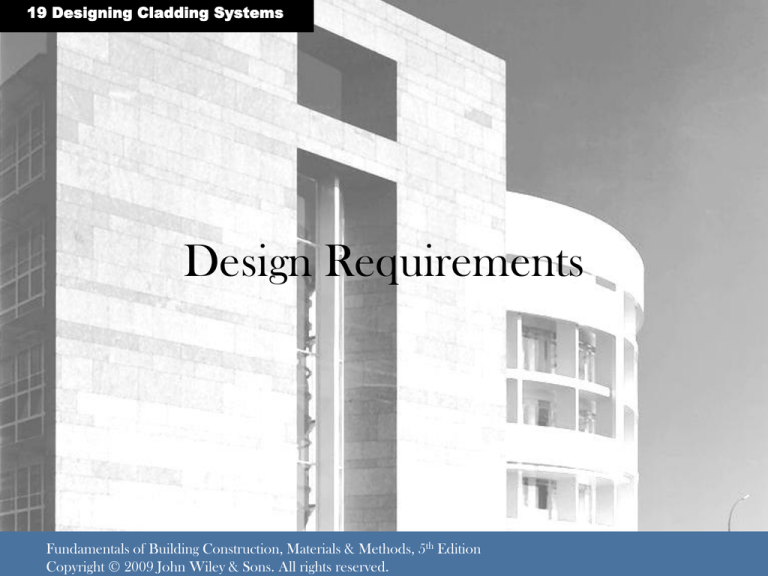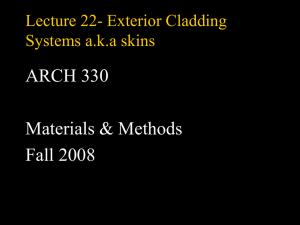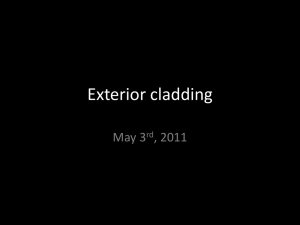
19 Designing Cladding Systems
Design Requirements
Fundamentals of Building Construction, Materials & Methods, 5th Edition
Copyright © 2009 John Wiley & Sons. All rights reserved.
Design Requirements For Cladding
Primary Functions of
Cladding
Modern Day Glass and Metal
Curtain Wall
• Keeping water out
–
–
–
Prevent the entry or rain, snow and
ice into the building
Water is driven inwards by many
forces such as wind, air pressures
and gravity
Water problems are more acute in
tall buildings
• Preventing air leakage
–
–
–
Prevent unintended passage of air
between indoors and outdoors
Smaller air leaks waste conditioned
air, carry water through the wall and
allow noise to penetrate
Large air leaks cause imbalance in
air distribution within the building
Fundamentals of Building Construction, Materials & Methods, 5th Edition
Copyright © 2009 John Wiley & Sons. All rights reserved.
Design Requirements For Cladding
Windows and Spandrel Panels
Primary Functions of
Cladding
• Controlling light
–
–
Control sunlight to balance between
useful illumination and detrimental
effects such as glare, fading of
materials and damage to skin
Control can be provided by balance
of amount of windows, exterior
shading devices, types of glass, and
interior blinds and curtains
• Controlling the radiation of heat
–
–
Interior surfaces can cause discomfort
due to radiant heat transfer in
summer and winter
Shading devices, thermal insulation,
thermal breaks and appropriate glass
can be used to control radiant heat
Fundamentals of Building Construction, Materials & Methods, 5th Edition
Copyright © 2009 John Wiley & Sons. All rights reserved.
Design Requirements For Cladding
Primary Functions of
Cladding
• Controlling conduction of heat
–
–
–
Resist the conduction of heat
into and out of the building
Requires insulation plus
avoidance of thermal bridges
Thermal insulation
requirements often dictated by
codes
• Controlling sound
–
–
Isolate the inside of the building
from noises outside and vice
versa
Requirements will vary by type
of building and their location
Fundamentals of Building Construction, Materials & Methods, 5th Edition
Copyright © 2009 John Wiley & Sons. All rights reserved.
Insulation in a Masonry
Cladding System
Design Requirements For Cladding
Primary Functions of
Cladding
• This cladding system uses
glass with varying optical
properties and external,
hanging shades to control
the passage of light and heat
into and out of the building.
Fundamentals of Building Construction, Materials & Methods, 5th Edition
Copyright © 2009 John Wiley & Sons. All rights reserved.
Design Requirements For Cladding
Wind Forces on Building Face
Secondary Functions of
Cladding
• Resisting wind forces
–
–
Provide adequate strength and
stiffness to sustain pressures
and suctions due to wind.
Pressure and suction will vary
by height and location of the
cladding elements such as
corners
• Controlling water vapor
–
–
Resist diffusion of water vapor
to parts within wall with
possibility of condensation
Such condensation can cause
loss of insulating value,
corrosion of metals, and decay
of wood
Fundamentals of Building Construction, Materials & Methods, 5th Edition
Copyright © 2009 John Wiley & Sons. All rights reserved.
Design Requirements For Cladding
Secondary Functions of
Cladding
• Movement – thermal expansion and
contraction
–
–
–
Accommodate movements due to
changes in temperature
Differential thermal expansion and
contraction of inside and outside of
cladding
Differential thermal expansion and
contraction of cladding relative to
frame
• Movement - moisture expansion and
contraction
–
Bricks, building stone, concrete and
wood change dimension due to
moisture content and can cause
problems which need to be taken
into account
Fundamentals of Building Construction, Materials & Methods, 5th Edition
Copyright © 2009 John Wiley & Sons. All rights reserved.
Design Requirements For Cladding
Secondary Functions of
Cladding
• Movement - Structural
–
Adjust to structural movements in
frame due to:
– Building foundation settlement
– Shortening of columns
– Wind and earthquake forces can
cause racking effect
– Long term creep of concrete
–
Wall systems can result in
–
–
–
–
–
Broken glass
Buckled cladding
Sealant failures
Broken cladding attachments
Failure of whole wall
Fundamentals of Building Construction, Materials & Methods, 5th Edition
Copyright © 2009 John Wiley & Sons. All rights reserved.
Design Requirements For Cladding
Secondary Functions of
Cladding
• Resisting Fire
–
–
The exterior wall of a building can
interact in several ways with building
fires
There are a number of building code
provisions relating to the construction
of building exterior walls systems with
respect to fire safety
• Weathering gracefully
–
–
–
Cladding must weather gracefully
Dirt and grime should not detract
from the aesthetics
Cladding must resist oxidation, UV
degradation, breakdown of organic
materials, corrosion of metallic
components, chemical attack and
freeze thaw damage
Fundamentals of Building Construction, Materials & Methods, 5th Edition
Copyright © 2009 John Wiley & Sons. All rights reserved.
Design Requirements For Cladding
Installation
Requirements for
Cladding
• Secure places for installers
• Tolerance for inaccuracies
• Dimensional clearances for
installation of components
• Levels of redundancy
–
–
Air barriers and drainage
channels to get rid of
moisture from faulty joints
Generous edge clearance
for glass to prevent contact
with hard surfaces
Fundamentals of Building Construction, Materials & Methods, 5th Edition
Copyright © 2009 John Wiley & Sons. All rights reserved.
19 Designing Cladding Systems
Conceptual Approaches to
Watertightness in Cladding
Fundamentals of Building Construction, Materials & Methods, 5th Edition
Copyright © 2009 John Wiley & Sons. All rights reserved.
Conceptual Approaches to Watertightness in Cladding
Conditions for Water
Penetration
• Water
–
Water can be kept away from the wall in
some situations by overhangs but otherwise
it is difficult to keep it away from the wall
• Opening
–
–
Openings can be eliminated by carefully
sealing every seam with membranes,
sealants or gaskets. Practically it is very
difficult to eliminate openings
Internal drainage can be provided to move
the penetrated water to the outside
– Force
–
Forces are always present. Forces can be
neutralized at a plane which is on the
outside of the weather barrier
Fundamentals of Building Construction, Materials & Methods, 5th Edition
Copyright © 2009 John Wiley & Sons. All rights reserved.
Conceptual Approaches to Watertightness in Cladding
Forces - Gravity
• Gravity
–
–
It is a factor in pulling
water through a wall only
if the wall contains an an
inclined plane that slopes
inwards.
Designing inclined planes
to drain away from the
interior is an effective
approach to deal with
water flow through gravity
Fundamentals of Building Construction, Materials & Methods, 5th Edition
Copyright © 2009 John Wiley & Sons. All rights reserved.
Conceptual Approaches to Watertightness in Cladding
Forces - Momentum
• Momentum
–
–
The momentum of falling
raindrops can drive water
through a wall only if
there is a suitably oriented
hole that goes completely
through the wall
Providing a cover to each
joint or designing a joint as
a labyrinth can neutralize
water driven by
momentum
Fundamentals of Building Construction, Materials & Methods, 5th Edition
Copyright © 2009 John Wiley & Sons. All rights reserved.
Conceptual Approaches to Watertightness in Cladding
Forces – Surface Tension
• Surface tension
–
–
The surface tension of
water which causes it to
adhere to the cladding
component in defiance of
gravity can allow water to
be drawn into the building
Provision of a simple drip
on any underside surface
to which water might
adhere helps with this
force
Fundamentals of Building Construction, Materials & Methods, 5th Edition
Copyright © 2009 John Wiley & Sons. All rights reserved.
Conceptual Approaches to Watertightness in Cladding
Forces – Capillary Action
• Capillary action
–
–
Capillary action is the
surface tension effect that
pulls water through any
opening that can be
bridged by a water drop
This force can be dealt
with by making openings
in walls wider than a water
drop or by providing
capillary breaks or by
providing coating of
silicone based water
repellant
Fundamentals of Building Construction, Materials & Methods, 5th Edition
Copyright © 2009 John Wiley & Sons. All rights reserved.
Conceptual Approaches to Watertightness in Cladding
Forces – Air Pressure
Difference
• Air pressure difference
–
–
–
It is caused by wind
currents which result in a
higher pressure on the
outside then the inside
that drives air and along
with it rain into the wall
It is the most difficult to
deal with in designing the
watertightness of the wall.
It can be neutralized by
employing pressureequalized wall design
Fundamentals of Building Construction, Materials & Methods, 5th Edition
Copyright © 2009 John Wiley & Sons. All rights reserved.
Conceptual Approaches to Watertightness in Cladding
Rainscreen Cladding and
Pressure Equalized Wall
Design
• Pressure-equalized wall design
–
–
–
–
–
–
Allow wind pressure differences to
neutralize
Involves creation of an air-barrier plane of
airtightness
Air barrier is protected by rainscreen
which is unsealed, labyrinth-jointed layer
Pressure equalization chamber (PEC) is
between the rainscreen and the air-barrier
PEC must be divided into compartments
to prevent cross currents
Rainscreen cladding is used to describe
systems that have internal drainage
regardless of the level of
compartmentalization and degree or
pressure equalization
Fundamentals of Building Construction, Materials & Methods, 5th Edition
Copyright © 2009 John Wiley & Sons. All rights reserved.
Conceptual Approaches to Watertightness in Cladding
Rainscreen Cladding and
Pressure Equalized Wall
Design
An Example of a Metal Panel
Pressure Equalized Wall
• Pressure equalized wall design
–
–
–
–
–
–
–
–
No surface joint sealants or gaskets
are used
The metal rainscreen panels do not
touch each other
Gaps preclude capillary movement,
provide installation tolerances and
allow for expansion and contraction
Labyrinth joints are created
Sloping surfaces couteract surface
tension and gravity
Installation is simple and forgiving
Space between the metal rainscreen
and insulation provides drainage
space
PEC is divided into narrow
compartments by vertical and
horizontal channels
Fundamentals of Building Construction, Materials & Methods, 5th Edition
Copyright © 2009 John Wiley & Sons. All rights reserved.
Conceptual Approaches to Watertightness in Cladding
Rainscreen Cladding and
Pressure Equalized Wall
Design
• Pressure equalization at a smaller
scale
–
–
–
–
–
Weatherstrip acts as an air
barrier
The open joint under the sash
rail is provided with a capillary
break and acts as a PEC
A wash or the slope on the sill
acts to facilitate water drainage
by gravity
The groove in the lower edge of
sash acts as a drip to counteract
surface tension
The L-shaped joint between the
sash and the sill acts as a
labyrinth
Fundamentals of Building Construction, Materials & Methods, 5th Edition
Copyright © 2009 John Wiley & Sons. All rights reserved.
19 Designing Cladding Systems
Sealant Joints in Cladding
Fundamentals of Building Construction, Materials & Methods, 5th Edition
Copyright © 2009 John Wiley & Sons. All rights reserved.
Sealant Joints in Cladding
Sealant Materials Gunnable
Sealant Material Applied Using a Gun
• Sealant materials - gunnable
–
–
Viscous, sticky liquids (mastic) that are injected
into the sealant joints with sealant gun
Cure to rubberlike materials in the joint
• Three categories of material
–
–
–
Low-range called caulks with low range elongation
used to fill minor cracks
Medium-range such as butyl rubber or acrylics
used for sealing nonworking joints
High-range such as polysulfides, polyurethanes
and silicones are highly resilient and durable for
20 years or more and used for working joints
– Characteristics
–
Elongation, number of components, pourable,
nonsag, traffic, and immersible
Fundamentals of Building Construction, Materials & Methods, 5th Edition
Copyright © 2009 John Wiley & Sons. All rights reserved.
Sealant Joints in Cladding
Sealant Materials Solid
• Gaskets
–
–
Strips of cured elastomeric
material
Compressed into joint or installed
using lockstrip insert
• Preformed cellular tapes
–
–
Strip of polyurethane sponge
material impregnated with mastic
sealant
Strip is compressed and expands
to fill joint after installation
• Preformed solid tape
–
Thick sticky ribbons of polybutene
or polyisobutylene used in lap
joints. They come with a release
tape
Fundamentals of Building Construction, Materials & Methods, 5th Edition
Copyright © 2009 John Wiley & Sons. All rights reserved.
Sealant Joints in Cladding
Sealant Joint Design and
Installation
• Tooling to ensure proper
surface contact
• Width to control strain
• Depth to control stress
• Correct proportioning to
control strain and stress
• Typical installation steps
–
–
–
–
Joint must be cleaned of oil,
dirt, oxide, moisture or
concrete form release
compound
Apply primer if necessary
Backer rod or backup rod is
inserted to limit the depth
Sealant is extruded into the
joint and tooled
Fundamentals of Building Construction, Materials & Methods, 5th Edition
Copyright © 2009 John Wiley & Sons. All rights reserved.
Sealant Joints in Cladding
Sealant Joint Design –
Proper Contact
• Sealant joint design – bond
breaker
–
–
Sealant should only
contact two sides of the
joint. If it contacts the
third side then the
effective width of the
sealant is reduced
resulting in extra strain
A bond breaker material
is used to prevent the
sealant from coming in
contact with more than
two sides
Fundamentals of Building Construction, Materials & Methods, 5th Edition
Copyright © 2009 John Wiley & Sons. All rights reserved.
Sealant Joints in Cladding
Temperature And Joint
Design
• Sealant joint design –
temperature
–
–
For a joint between materials
with high coefficients of
expansion, the time of the
year when the sealant is to be
installed must be taken into
account when specifying the
size of the joint and the type
of the sealant
Sealants installed in cold
weather will have to stretch
less but compress more and
vice versa for sealant installed
in hot weather
Fundamentals of Building Construction, Materials & Methods, 5th Edition
Copyright © 2009 John Wiley & Sons. All rights reserved.
19 Designing Cladding Systems
Basic Concepts Of
Cladding Systems
Fundamentals of Building Construction, Materials & Methods, 5th Edition
Copyright © 2009 John Wiley & Sons. All rights reserved.
Basic Concepts of Cladding Systems
Load Bearing and
Curtain Wall
• Load bearing
–
–
–
Until late in the 19th century all large buildings were built with loadbearing
walls
They were poor insulators, developed water leaks and heavy requiring large
foundations
Modern day loadbearing walls have been brought up to date with higher
strength masonry and concrete with components such as steel reinforcing,
insulation, cavities, flashings, air barriers, vapor retarders. They are used in
low and medium rise buildings
• Curtain Wall
–
–
–
–
The concept of curtain wall was introduced in late 19th century with the
advent of skyscrapers
It is an exterior wall supported at each story by a frame and derives from
the idea that the wall is thin and hangs like a curtain on the structural frame
It bears no vertical load and can be thin and light in weight
Curtain walls may be constructed in place or prefabricated of masonry,
concrete, metal and glass
Fundamentals of Building Construction, Materials & Methods, 5th Edition
Copyright © 2009 John Wiley & Sons. All rights reserved.
19 Designing Cladding Systems
Testing And Codes
Fundamentals of Building Construction, Materials & Methods, 5th Edition
Copyright © 2009 John Wiley & Sons. All rights reserved.
Testing and Codes
Testing Cladding
Systems
• Types of tests
–
–
–
–
Schematic Showing Water Leakage
Testing of Exterior Wall in a Test
Chamber
Resistance to infiltration of air
Resistance to infiltration of water
Structural performance
Thermal Properties
• Scale
–
Typically full-scale tests often with two
storey high specimen are conducted in
laboratory
• Standards
–
Many standards such as AAMA,
ASTM, and CSA
• Field Testing
–
Often field testing is conducted to
ensure that performance of installed
system is similar to designed system
Fundamentals of Building Construction, Materials & Methods, 5th Edition
Copyright © 2009 John Wiley & Sons. All rights reserved.
Testing and Codes
Cladding and the
Building Codes
Installation of Firestopping using Safing
• Major impact of building codes on the
design of exterior wall is in the following
areas
–
–
–
Structural strength
Fire resistance
Energy efficiency
• Structural
–
Strength and stiffness of wall and
adequacy of attachment
• Fire
–
–
–
Combustibility
Fire resistance rating
Firestopping
• Energy
–
–
–
Minimum thermal resistance
Maximum levels of air leakage
Performance requirements
Fundamentals of Building Construction, Materials & Methods, 5th Edition
Copyright © 2009 John Wiley & Sons. All rights reserved.





